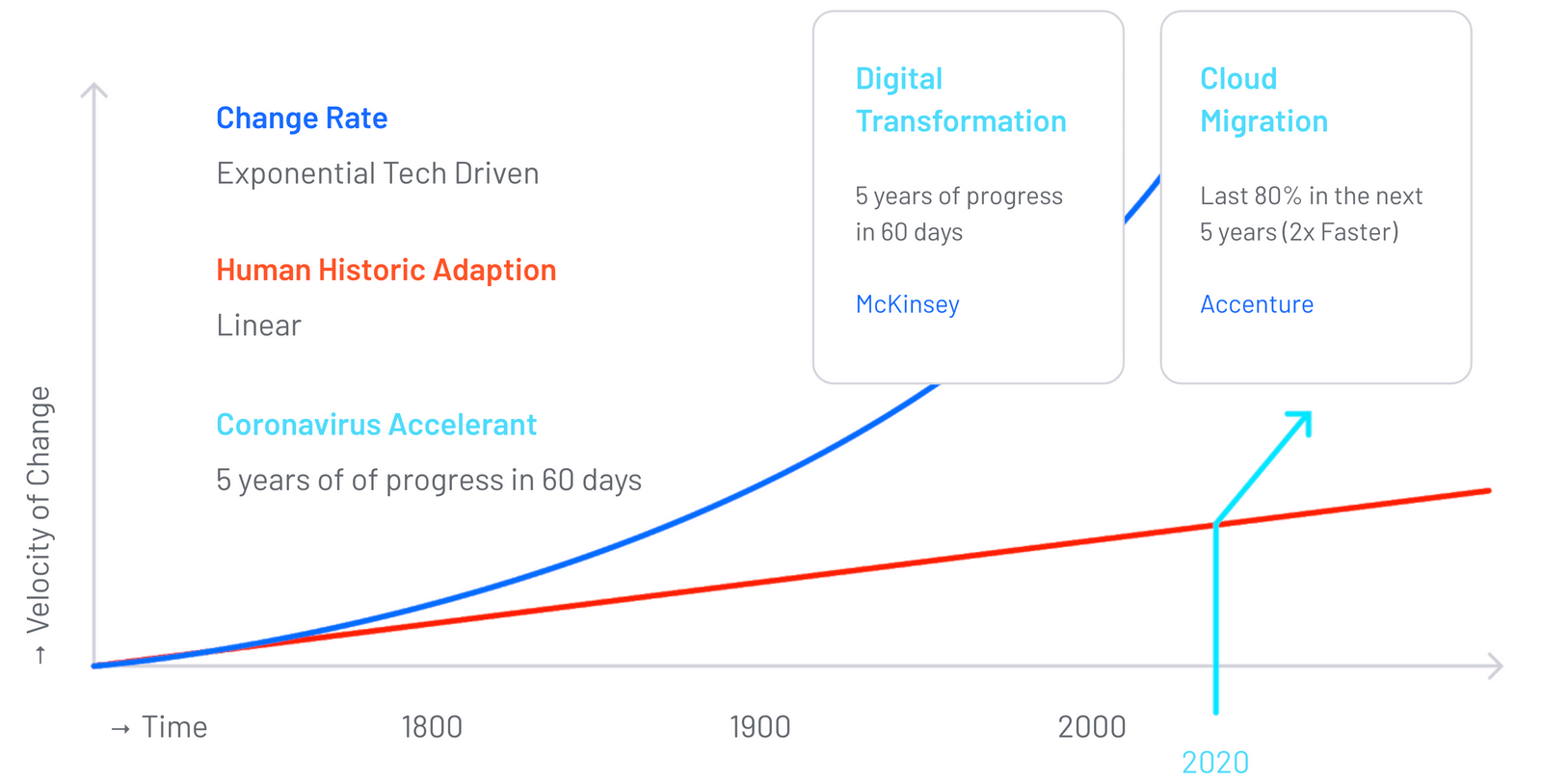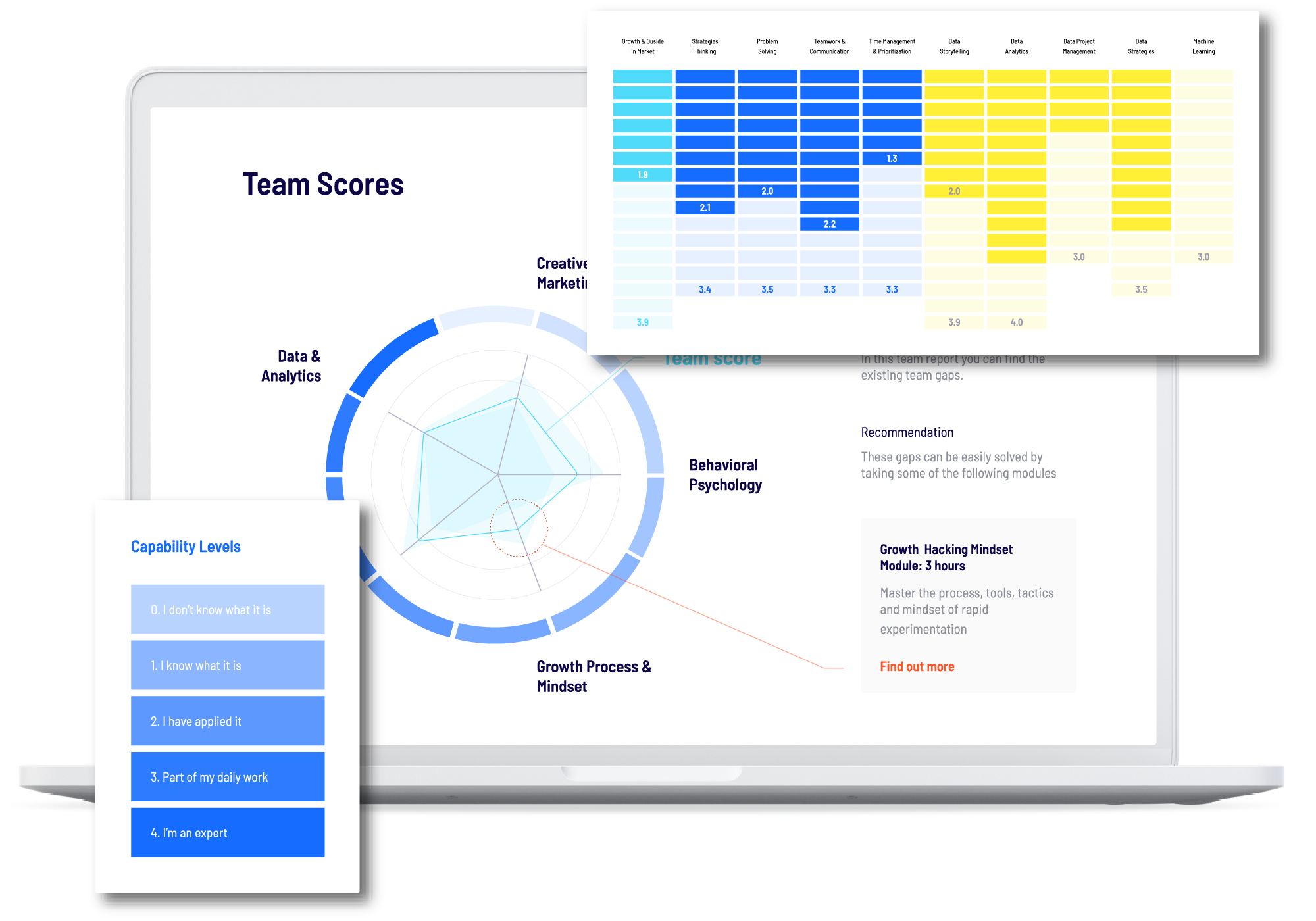The context in which this report finds itself in your hands, or rather, screen, is the stuff of science fiction. Yet, it is an eerie scientific fact that we are all living. The weight of history presses heavily on all our lives and we stand at a crossroad for human development. What we do now will determine the direction we take in the future.
That is why we set out to measure skills and capabilities in the European population - so that collectively we can change our reality, and move towards a brighter, more human future.
The Skills of Tomorrow. Today.
The Impact of COVID-19
Since the World Health Organisation declared a pandemic on March 11th 2020, the world as we knew it has been flipped upside down.
Governments, businesses and individuals have had to take drastic measures to address the crisis at hand. Infrastructure, existing inequalities, how we work, interact and live have all been put under immense strain.
Yet, COVID-19 may well turn out to be one of the greatest catalysts for change in modern history. We have been talking about digital transformation and technology transformations for well over a decade now. Yet, these were happening comparatively slowly. Now, we are in the full throes of a digital business revolution. With COVID-19 as the accelerant. In just sixty days during the first lockdown, 5 years of Digital Transformation was achieved by businesses and consumers according to McKinsey.
As businesses have adopted remote working, digital customer service has become the norm and e-commerce has boomed.
Human capital - our best bet on long-term value creation

The 4th Industrial Revolution
Prior to today, as a species, we had been through three industrial revolutions:
1st
Mechanical
Job
2nd
Electrical
Job
3rd
Internet
Job
4th
Convergence
Job
And as Professor Klaus Schwab describes in his book, The Fourth Industrial Revolution, the current revolution, is fundamentally different from the previous three, which were defined mainly by advances in technology. In this fourth revolution, we are facing a range of new technologies that combine the physical, digital and biological worlds in the Internet of Things, and the Internet of Systems.
These new technologies will impact all disciplines, economies and industries, and even challenge our ideas about what it means to be human. And what makes this a distinct revolution from previous ones, is that the speed of change will have no historical precedent. When compared with previous industrial revolutions, the Fourth is evolving at an exponential, rather than a linear pace.
As with any great revolution, there come great risks and rewards.
One of the greatest potential rewards of the Fourth Industrial Revolution is to raise income levels and vastly improve the quality of our lives as a species.
The potential created by billions of people being connected through mobile devices, and their collective processing power, memory and instant access to knowledge are immense. Multiply that with breakthroughs in artificial intelligence, robotics, the Internet of Things, autonomous vehicles, nanotechnology, energy storage, and the list goes on. You soon begin to see the cusp of greatness we stand upon.
We will move into an age of abundance, with innovation driving a supply-side miracle, with long-term gains in efficiency and productivity. The cost of goods and services will drop, and frictions to trade will fall away, opening up new markets and growth opportunities.
The risk to this panacea is that as with previous revolutions inequalities could grow, rather than shrink.
With the creation of vast winners and losers, “high-skill/high-pay” and “low-skill/low-pay” segments in the workforce.
Social tensions could then rise, fuelled by our greater connectivity. In fact, our institutions may need to be rethought to deal with this new world.
Schwab highlights his greatest fear is that decision-makers are too caught up in traditional, linear (and non-disruptive) thinking or too absorbed by immediate concerns to think strategically about the forces of disruption and innovation shaping our future.
Schwab calls for leaders and citizens to “together shape a future that works for all by putting people first, empowering them and constantly reminding ourselves that all of these new technologies are first and foremost tools made by people for people.
The Future of Jobs
What does all of this mean for the future of jobs?
According to the World Economic Forum’s Future of Jobs Survey 2020,
employers expect that by 2025:
In total, they anticipate that by 2025 85 million job may be displaced by a shift in the division of labour between humans and machines, while 97 million new roles may emerge that are more adapted to the new division of labour between humans, machines and algorithms.
The leading professions growing in demand are roles such as Data Analysts and Scientists, AI and Machine Learning Specialists, Robotics Engineers, Software and Application developers as well as Digital Transformation Specialists.
However, job roles such as Process Automation Specialists, Information Security Analysts and Internet of Things Specialists are newly emerging. Reflecting the shift into the Fourth Industrial Revolution and the acceleration of automation.
Roles showing increasing and decreasing demand:
- Data Analyst and Scientist
- A.I. and Machine Learning Specialists
- Big Data Specialists
- Marketing & Strategy Specialists
- Process Automation Specialists
- Business Dev Professionals
- Digital Transformation Specialists
- Information Security Analysts
- Software & App Developers
- Internet of Things Specialists
- Data Entry Clerk
- Admin & Executive Secretaries
- Acc., Bookkeeping & Payroll Clerk
- Accountants & Auditors
- Assembly & Factory Workers
- Business Ser. & Admin Managers
- Client & Customer Ser. Workers
- General & Operations Manager
- Mechanics & Machinery Repairers
- Stock-Keeping Clerks
Yet, the ability of global companies to harness the growth potential of new technology adoption is hindered by skills shortages. According to the World Economic Forum's Future of Jobs Report, 50% of all employees will need reskilling by 2025, as the adoption of technology increases.
The Digital Skills Gap
Staring into the Skills Abyss
Which leads us to the digital skills gap. Or as Heather E. McGowan and Chris Shipley, coin in their book, The Adaptation Advantage, the Skills Abyss.
In Human History a skills gap has been omnipresent. There has always been a gap between those with the skills to use tools and fulfil a job, and the demand for and adoption of those skills in the community.
Historically skills were passed from one skilled person to the next, then in more complex forms like apprenticeships and universities. The next phase, however, requires something new:
The Evolution of Work - The Adaptation Advantage
Do everything yourself
Learn a tradable skill
Learn increasingly specialised skills
Learn transferable skills + adaptability
The old models worked when the adoption of skills was slow. A skill lasted for a lifetime, or could easily be updated as demand dictated.
Now we are entering the perfect storm for skills. The pace of change has moved from linear to exponential causing skills to perish at a faster rate. As new skills continuously enter the market in line with technological innovation, and demand skyrockets.

IBM presents research that suggests that “skills generally have a ‘half-life’ of about five years, with more technical skills at just two and a half years.”
As perishable skills are replaced by more efficient technologies and processes, and new skills emerge at a greater pace, the skills gap becomes a skills abyss.
Rethinking Skills
The Era of Human Capital
Digital transformation is, at its core, human transformation. No matter how sophisticated technology and tools become, their foundation rests on humans. As new tools have become necessary, human skills have adapted rapidly in response. As a result, the author Heather E. McGowan states we are entering a new economic era, the Human Capital Era.
Both workers and companies must continuously expand their capacity— to upskill, reskill, learn, unlearn, and explore frontiers beyond the known and familiar. To do this well, we must – at every level – make a deeper investment in humans, knowing that the greatest return on investment will come from investing in human potential. Skills perish too fast and learning is the new modus operandi.
As lifespans have increased systematically since the 1960s, people will need to work longer throughout their lives. Career spans of 35-40 years will become up to 60 years long. Couple this with the diminishing lifespan of perishable skills, we see a new model arising for human careers.
One where our lives and work lives are longer and learning is lifelong and continuous:
Rethinking the life blocks - The Human Capital Model
Old Model
Emerging Faulty Logic Model
Human Capital Model
In the Human Capital Era - human potential, unlocked through learning, offers the greatest long term return on investment.

Coursera data reveals the direct correlation between skills proficiency i.e. human capital, and U.S. stock return performance.
The correlation between an industry’s skill proficiency and its U.S stock return is 40%- in other words, companies with higher skill proficiency have seen their valuation disrupted less by COVID-19.
The State of Learning & Development
Despite the gap between skills and technology, a report by Bersin found that among more than 700 organizations studied, the average employee had only 24 minutes a week for deliberate learning.
The highest long term return on investment currently receives the lowest human and capital investment.
The illiterate of the 21st century will not be those who cannot read and write, but those who cannot learn, unlearn, and relearn.
Alvin Toffler
The facts show us that learning is consistently overlooked:
- Less than 3% of Fortune 1000 companies have HR or L&D represented on the board (although 41% of L&D leaders do meet with the C-Suite weekly, and get buy-in directly from the CEO)
- Midsize and large organizations (500-10k headcount) spend a tiny €714 per year on employee learning and development
- According to CEB research, only around 1 in 10 companies have a true learning culture, (that supports an independent quest for knowledge, and shared learning directed toward the mission and goals of the organization)
- According to the same research, only 20% of employees demonstrate effective learning behaviours
- Most CEOs declare not knowing what the impact of learning efforts are
The aim of this report
We set out to measure current skills and capabilities so that we have a gauge of where we are and where we need to go. Now more than ever, we need to address the capabilities of our workforce and invest in human capital through learning. This report focuses on European professionals working in Data and Marketing, two of the fastest-growing and most in-demand areas of the future.
We ran vision interviews with business and Learning and Development leaders to gain contextual information on the challenges facing businesses at the moment. Then, at the core of this report is our capability scan for marketing and data professionals. The scan asked over 50 questions to measure 6 core capability areas and specific skill sets. The outcome tells us the strengths and weaknesses of the marketing and data population in Europe, with those skills showing the biggest gap between demand and supply signalling the skills of tomorrow.
Want to know your team's capability baselines?
This lite version of our capability analysis software is designed to help you understand your teams growth capability gaps. It takes around 15-20mins.


